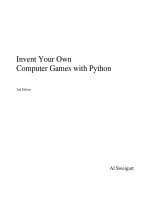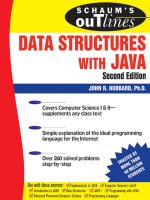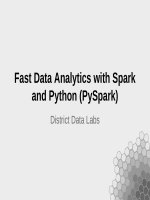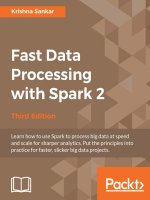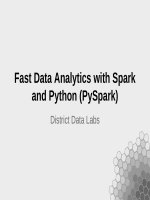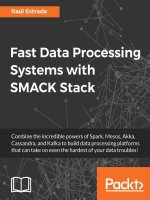Fast data processing with spark, 2nd edition
Bạn đang xem bản rút gọn của tài liệu. Xem và tải ngay bản đầy đủ của tài liệu tại đây (7.91 MB, 184 trang )
www.allitebooks.com
Fast Data Processing
with Spark
Second Edition
Perform real-time analytics using Spark in a fast,
distributed, and scalable way
Krishna Sankar
Holden Karau
BIRMINGHAM - MUMBAI
www.allitebooks.com
Fast Data Processing with Spark
Second Edition
Copyright © 2015 Packt Publishing
All rights reserved. No part of this book may be reproduced, stored in a retrieval
system, or transmitted in any form or by any means, without the prior written
permission of the publisher, except in the case of brief quotations embedded in
critical articles or reviews.
Every effort has been made in the preparation of this book to ensure the accuracy
of the information presented. However, the information contained in this book is
sold without warranty, either express or implied. Neither the authors, nor Packt
Publishing, and its dealers and distributors will be held liable for any damages
caused or alleged to be caused directly or indirectly by this book.
Packt Publishing has endeavored to provide trademark information about all of the
companies and products mentioned in this book by the appropriate use of capitals.
However, Packt Publishing cannot guarantee the accuracy of this information.
First published: October 2013
Second edition: March 2015
Production reference: 1250315
Published by Packt Publishing Ltd.
Livery Place
35 Livery Street
Birmingham B3 2PB, UK.
ISBN 978-1-78439-257-4
www.packtpub.com
www.allitebooks.com
Credits
Authors
Copy Editor
Krishna Sankar
Hiral Bhat
Holden Karau
Project Coordinator
Neha Bhatnagar
Reviewers
Robin East
Proofreaders
Toni Verbeiren
Maria Gould
Lijie Xu
Ameesha Green
Commissioning Editor
Joanna McMahon
Akram Hussain
Indexer
Acquisition Editors
Tejal Soni
Shaon Basu
Production Coordinator
Kunal Parikh
Nilesh R. Mohite
Content Development Editor
Cover Work
Arvind Koul
Nilesh R. Mohite
Technical Editors
Madhunikita Sunil Chindarkar
Taabish Khan
www.allitebooks.com
About the Authors
Krishna Sankar is a chief data scientist at />where he focuses on optimizing user experiences via inference, intelligence, and
interfaces. His earlier roles include principal architect, data scientist at Tata America
Intl, director of a data science and bioinformatics start-up, and a distinguished
engineer at Cisco. He has spoken at various conferences, such as Strata-Sparkcamp,
OSCON, Pycon, and Pydata about predicting NFL ( Spark
( data science ( machine learning
( and social media analysis ( He
was a guest lecturer at Naval Postgraduate School, Monterey. His blogs can be found
at His other passion is Lego Robotics. You
can ind him at the St. Louis FLL World Competition as the robots design judge.
The credit goes to my coauthor, Holden Karau, the reviewers, and
the editors at Packt Publishing. Holden wrote the irst edition, and I
hope I was able to contribute to the same depth. I am deeply thankful
to the reviewers Lijie, Robin, and Toni. They spent time diligently
reviewing the material and code. They have added lots of insightful
tips to the text, which I have gratefully included. In addition, their
sharp eyes caught tons of errors in the code and text. Thanks to
Arvind Koul, who has been the chief force behind the book. A great
editor is absolutely essential for the completion of a book, and I
was lucky to have Arvind. I also want to thank the editors at Packt
Publishing: Anila, Madhunikita, Milton, Neha, and Shaon, with whom
I had the fortune to work with at various stages. The guidance and
wisdom from Joe Matarese, my boss at ckarrow.
tv/, and from Paco Nathan at Databricks are invaluable. My spouse,
Usha and son Kaushik, were always with me, cheering me on for any
endeavor that I embark upon—mostly successful, like this book, and
occasionally foolhardy efforts! I dedicate this book to my mom, who
unfortunately passed away last month; she was always proud to see
her eldest son as an author.
www.allitebooks.com
Holden Karau is a software development engineer and is active in the open source
sphere. She has worked on a variety of search, classiication, and distributed systems
problems at Databricks, Google, Foursquare, and Amazon. She graduated from the
University of Waterloo with a bachelor's of mathematics degree in computer science.
Other than software, she enjoys playing with ire and hula hoops, and welding.
www.allitebooks.com
About the Reviewers
Robin East has served a wide range of roles covering operations research, inance,
IT system development, and data science. In the 1980s, he was developing credit
scoring models using data science and big data before anyone (including himself)
had even heard of those terms! In the last 15 years, he has worked with numerous
large organizations, implementing enterprise content search applications, content
intelligence systems, and big data processing systems. He has created numerous
solutions, ranging from swaps and derivatives in the banking sector to fashion
analytics in the retail sector.
Robin became interested in Apache Spark after realizing the limitations of the
traditional MapReduce model with respect to running iterative machine learning
models. His focus is now on trying to further extend the Spark machine learning
libraries, and also on teaching how Spark can be used in data science and data
analytics through his blog, Machine Learning at Speed (http://mlspeed.
wordpress.com).
Before NoSQL databases became the rage, he was an expert on tuning Oracle
databases and extracting maximum performance from EMC Documentum systems.
This work took him to clients around the world and led him to create the open
source proiling tool called DFCprof that is used by hundreds of EMC users to
track down performance problems. For many years, he maintained the popular
Documentum internals and tuning blog, Inside Documentum (http://robineast.
wordpress.com), and contributed hundreds of posts to EMC support forums. These
community efforts bore fruit in the form of the award of EMC MVP and acceptance
into the EMC Elect program.
www.allitebooks.com
Toni Verbeiren graduated as a PhD in theoretical physics in 2003. He used to
work on models of artiicial neural networks, entailing mathematics, statistics,
simulations, (lots of) data, and numerical computations. Since then, he has been
active in the industry in diverse domains and roles: infrastructure management and
deployment, service management, IT management, ICT/business alignment, and
enterprise architecture. Around 2010, Toni started picking up his earlier passion,
which was then named data science. The combination of data and common sense can
be a very powerful basis to make decisions and analyze risk.
Toni is active as an owner and consultant at Data Intuitive ( in everything related to big data science and its applications to
decision and risk management. He is currently involved in Exascience Life Lab
( and the Visual Data Analysis Lab (http://vda-lab.
be/), which is concerned with scaling up visual analysis of biological and chemical data.
I'd like to thank various employers, clients, and colleagues for the
insight and wisdom they shared with me. I'm grateful to the Belgian
and Flemish governments (FWO, IWT) for inancial support of the
aforementioned academic projects.
Lijie Xu is a PhD student at the Institute of Software, Chinese Academy of Sciences.
His research interests focus on distributed systems and large-scale data analysis.
He has both academic and industrial experience in Microsoft Research Asia,
Alibaba Taobao, and Tencent. As an open source software enthusiast, he has
contributed to Apache Spark and written a popular technical report, named
Spark Internals, in Chinese at />tree/master/markdown.
www.allitebooks.com
www.PacktPub.com
Support iles, eBooks, discount offers,
and more
For support iles and downloads related to your book, please visit www.PacktPub.com.
Did you know that Packt offers eBook versions of every book published, with PDF
and ePub iles available? You can upgrade to the eBook version at www.PacktPub.
com and as a print book customer, you are entitled to a discount on the eBook copy.
Get in touch with us at for more details.
At www.PacktPub.com, you can also read a collection of free technical articles, sign
up for a range of free newsletters and receive exclusive discounts and offers on Packt
books and eBooks.
TM
/>
Do you need instant solutions to your IT questions? PacktLib is Packt's online digital
book library. Here, you can search, access, and read Packt's entire library of books.
Why subscribe?
•
•
•
Fully searchable across every book published by Packt
Copy and paste, print, and bookmark content
On demand and accessible via a web browser
Free access for Packt account holders
If you have an account with Packt at www.PacktPub.com, you can use this to access
PacktLib today and view 9 entirely free books. Simply use your login credentials for
immediate access.
www.allitebooks.com
Table of Contents
Preface
Chapter 1: Installing Spark and Setting up your Cluster
Directory organization and convention
Installing prebuilt distribution
Building Spark from source
Downloading the source
Compiling the source with Maven
Compilation switches
Testing the installation
Spark topology
A single machine
Running Spark on EC2
Running Spark on EC2 with the scripts
Deploying Spark on Elastic MapReduce
Deploying Spark with Chef (Opscode)
Deploying Spark on Mesos
Spark on YARN
Spark Standalone mode
Summary
Chapter 2: Using the Spark Shell
v
1
2
3
4
5
5
7
7
7
9
9
10
16
17
18
19
19
24
25
Loading a simple text ile
Using the Spark shell to run logistic regression
Interactively loading data from S3
Running Spark shell in Python
Summary
[i]
www.allitebooks.com
26
29
32
34
35
Table of Contents
Chapter 3: Building and Running a Spark Application
37
Chapter 4: Creating a SparkContext
45
Chapter 5: Loading and Saving Data in Spark
51
Building your Spark project with sbt
Building your Spark job with Maven
Building your Spark job with something else
Summary
Scala
Java
SparkContext – metadata
Shared Java and Scala APIs
Python
Summary
RDDs
Loading data into an RDD
Saving your data
Summary
Chapter 6: Manipulating your RDD
Manipulating your RDD in Scala and Java
Scala RDD functions
Functions for joining PairRDDs
Other PairRDD functions
Double RDD functions
General RDD functions
Java RDD functions
37
41
44
44
46
46
47
49
49
50
51
52
62
63
65
65
76
76
77
78
79
81
Spark Java function classes
Common Java RDD functions
Methods for combining JavaRDDs
Functions on JavaPairRDDs
81
82
83
84
Manipulating your RDD in Python
Standard RDD functions
PairRDD functions
Summary
85
88
89
91
Chapter 7: Spark SQL
93
The Spark SQL architecture
Spark SQL how-to in a nutshell
Spark SQL programming
94
94
95
SQL access to a simple data table
Handling multiple tables with Spark SQL
Aftermath
95
98
104
Summary
105
[ ii ]
Table of Contents
Chapter 8: Spark with Big Data
107
Chapter 9: Machine Learning Using Spark MLlib
119
Parquet – an eficient and interoperable big data format
Saving iles to the Parquet format
Loading Parquet iles
Saving processed RDD in the Parquet format
Querying Parquet iles with Impala
HBase
Loading from HBase
Saving to HBase
Other HBase operations
Summary
The Spark machine learning algorithm table
Spark MLlib examples
Basic statistics
Linear regression
Classiication
Clustering
Recommendation
Summary
107
108
109
111
111
114
115
116
117
118
120
120
121
124
126
132
136
140
Chapter 10: Testing
141
Chapter 11: Tips and Tricks
151
Testing in Java and Scala
Making your code testable
Testing interactions with SparkContext
Testing in Python
Summary
Where to ind logs
Concurrency limitations
Memory usage and garbage collection
Serialization
IDE integration
Using Spark with other languages
A quick note on security
Community developed packages
Mailing lists
Summary
Index
141
141
144
148
150
151
151
152
153
153
155
155
155
155
156
157
[ iii ]
Preface
Apache Spark has captured the imagination of the analytics and big data developers,
and rightfully so. In a nutshell, Spark enables distributed computing on a large scale
in the lab or in production. Till now, the pipeline collect-store-transform was distinct
from the Data Science pipeline reason-model, which was again distinct from the
deployment of the analytics and machine learning models. Now, with Spark and
technologies, such as Kafka, we can seamlessly span the data management and data
science pipelines. We can build data science models on larger datasets, requiring
not just sample data. However, whatever models we build can be deployed into
production (with added work from engineering on the "ilities", of course). It is our
hope that this book would enable an engineer to get familiar with the fundamentals
of the Spark platform as well as provide hands-on experience on some of the
advanced capabilities.
What this book covers
Chapter 1, Installing Spark and Setting up your Cluster, discusses some common
methods for setting up Spark.
Chapter 2, Using the Spark Shell, introduces the command line for Spark. The Shell is
good for trying out quick program snippets or just iguring out the syntax of a call
interactively.
Chapter 3, Building and Running a Spark Application, covers Maven and sbt for
compiling Spark applications.
Chapter 4, Creating a SparkContext, describes the programming aspects of the
connection to a Spark server, for example, the SparkContext.
Chapter 5, Loading and Saving Data in Spark, deals with how we can get data in and out
of a Spark environment.
[v]
Preface
Chapter 6, Manipulating your RDD, describes how to program the Resilient
Distributed Datasets, which is the fundamental data abstraction in Spark that makes
all the magic possible.
Chapter 7, Spark SQL, deals with the SQL interface in Spark. Spark SQL probably is
the most widely used feature.
Chapter 8, Spark with Big Data, describes the interfaces with Parquet and HBase.
Chapter 9, Machine Learning Using Spark MLlib, talks about regression, classiication,
clustering, and recommendation. This is probably the largest chapter in this book. If
you are stranded on a remote island and could take only one chapter with you, this
should be the one!
Chapter 10, Testing, talks about the importance of testing distributed applications.
Chapter 11, Tips and Tricks, distills some of the things we have seen. Our hope is that
as you get more and more adept in Spark programming, you will add this to the list
and send us your gems for us to include in the next version of this book!
What you need for this book
Like any development platform, learning to develop systems with Spark takes trial
and error. Writing programs, encountering errors, agonizing over pesky bugs are
all part of the process. We expect a basic level of programming skills—Python or
Java—and experience in working with operating system commands. We have kept
the examples simple and to the point. In terms of resources, we do not assume any
esoteric equipment for running the examples and developing the code. A normal
development machine is enough.
Who this book is for
Data scientists and data engineers would beneit more from this book. Folks who have
an exposure to big data and analytics will recognize the patterns and the pragmas.
Having said that, anyone who wants to understand distributed programming would
beneit from working through the examples and reading the book.
[ vi ]
Preface
Conventions
In this book, you will ind a number of text styles that distinguish between different
kinds of information. Here are some examples of these styles and an explanation of
their meaning.
Code words in text, database table names, folder names, ilenames, ile extensions,
pathnames, dummy URLs, user input, and Twitter handles are shown as follows:
"While the methods for loading an RDD are largely found in the SparkContext
class, the methods for saving an RDD are deined on the RDD classes."
A block of code is set as follows:
//Next two lines only needed if you decide to use the assembly plugin
import AssemblyKeys._assemblySettings
scalaVersion := "2.10.4"
name := "groupbytest"
libraryDependencies ++= Seq(
"org.spark-project" % "spark-core_2.10" % "1.1.0"
)
Any command-line input or output is written as follows:
scala> val inFile = sc.textFile("./spam.data")
New terms and important words are shown in bold. Words that you see on the
screen, for example, in menus or dialog boxes, appear in the text like this: " Select
Source Code from option 2. Choose a package type and either download directly
or select a mirror."
Warnings or important notes appear in a box like this.
Tips and tricks appear like this.
[ vii ]
Preface
Reader feedback
Feedback from our readers is always welcome. Let us know what you think about
this book—what you liked or disliked. Reader feedback is important for us as it helps
us develop titles that you will really get the most out of.
To send us general feedback, simply e-mail , and mention
the book's title in the subject of your message.
If there is a topic that you have expertise in and you are interested in either writing
or contributing to a book, see our author guide at www.packtpub.com/authors.
Customer support
Now that you are the proud owner of a Packt book, we have a number of things to
help you to get the most from your purchase.
Downloading the example code
You can download the example code iles from your account at http://www.
packtpub.com for all the Packt Publishing books you have purchased. If you
purchased this book elsewhere, you can visit />and register to have the iles e-mailed directly to you.
Errata
Although we have taken every care to ensure the accuracy of our content, mistakes
do happen. If you ind a mistake in one of our books—maybe a mistake in the text or
the code—we would be grateful if you could report this to us. By doing so, you can
save other readers from frustration and help us improve subsequent versions of this
book. If you ind any errata, please report them by visiting ktpub.
com/submit-errata, selecting your book, clicking on the Errata Submission Form
link, and entering the details of your errata. Once your errata are veriied, your
submission will be accepted and the errata will be uploaded to our website or added
to any list of existing errata under the Errata section of that title.
To view the previously submitted errata, go to />content/support and enter the name of the book in the search ield. The required
information will appear under the Errata section.
[ viii ]
Preface
Piracy
Piracy of copyrighted material on the Internet is an ongoing problem across all
media. At Packt, we take the protection of our copyright and licenses very seriously.
If you come across any illegal copies of our works in any form on the Internet, please
provide us with the location address or website name immediately so that we can
pursue a remedy.
Please contact us at with a link to the suspected pirated
material.
We appreciate your help in protecting our authors and our ability to bring you
valuable content.
Questions
If you have a problem with any aspect of this book, you can contact us at
, and we will do our best to address the problem.
[ ix ]
Installing Spark and Setting
up your Cluster
This chapter will detail some common methods to set up Spark. Spark on a single
machine is excellent for testing or exploring small datasets, but here you will also learn
to use Spark's built-in deployment scripts with a dedicated cluster via SSH (Secure
Shell). This chapter will explain the use of Mesos and Hadoop clusters with YARN or
Chef to deploy Spark. For Cloud deployments of Spark, this chapter will look at EC2
(both traditional and EC2MR). Feel free to skip this chapter if you already have your
local Spark instance installed and want to get straight to programming.
Regardless of how you are going to deploy Spark, you will want to get the latest
version of Spark from (Version
1.2.0 as of this writing). Spark currently releases every 90 days. For coders who want
to work with the latest builds, try cloning the code directly from the repository at
The building instructions are available at
Both source
code and prebuilt binaries are available at this link. To interact with Hadoop
Distributed File System (HDFS), you need to use Spark, which is built against the
same version of Hadoop as your cluster. For Version 1.1.0 of Spark, the prebuilt
package is built against the available Hadoop Versions 1.x, 2.3, and 2.4. If you are up
for the challenge, it's recommended that you build against the source as it gives you
the lexibility of choosing which HDFS Version you want to support as well as apply
patches with. In this chapter, we will do both.
To compile the Spark source, you will need the appropriate version of Scala and the
matching JDK. The Spark source tar includes the required Scala components. The
following discussion is only for information—there is no need to install Scala.
[1]
www.allitebooks.com
Installing Spark and Setting up your Cluster
The Spark developers have done a good job of managing the dependencies. Refer to
the web page
for the latest information on this. According to the website, "Building Spark using
Maven requires Maven 3.0.4 or newer and Java 6+." Scala gets pulled down as a
dependency by Maven (currently Scala 2.10.4). Scala does not need to be installed
separately, it is just a bundled dependency.
Just as a note, Spark 1.1.0 requires Scala 2.10.4 while the 1.2.0 version would run on
2.10 and Scala 2.11. I just saw e-mails in the Spark users' group on this.
This brings up another interesting point about the Spark
community. The two essential mailing lists are user@
spark.apache.org and
More details about the Spark community are available at
/>
Directory organization and convention
One convention that would be handy is to download and install software in the /opt
directory. Also have a generic soft link to Spark that points to the current version. For
example, /opt/spark points to /opt/spark-1.1.0 with the following command:
sudo ln -f -s spark-1.1.0 spark
Later, if you upgrade, say to Spark 1.2, you can change the softlink.
But remember to copy any coniguration changes and old logs when you change
to a new distribution. A more lexible way is to change the coniguration directory
to /etc/opt/spark and the log iles to /var/log/spark/. That way, these
will stay independent of the distribution updates. More details are available at
and />configuration.html#configuring-logging.
[2]
Chapter 1
Installing prebuilt distribution
Let's download prebuilt Spark and install it. Later, we will also compile a Version
and build from the source. The download is straightforward. The page to go to for
this is Select the options as shown in
the following screenshot:
We will do a wget from the command line. You can do a direct download as well:
cd /opt
sudo wget />
We are downloading the prebuilt version for Apache Hadoop 2.4 from one of the
possible mirrors. We could have easily downloaded other prebuilt versions as well,
as shown in the following screenshot:
[3]
Installing Spark and Setting up your Cluster
To uncompress it, execute the following command:
tar xvf spark-1.1.1-bin-hadoop2.4.tgz
To test the installation, run the following command:
/opt/spark-1.1.1-bin-hadoop2.4/bin/run-example SparkPi 10
It will ire up the Spark stack and calculate the value of Pi. The result should be as
shown in the following screenshot:
Building Spark from source
Let's compile Spark on a new AWS instance. That way you can clearly understand
what all the requirements are to get a Spark stack compiled and installed. I am using
the Amazon Linux AMI, which has Java and other base stack installed by default.
As this is a book on Spark, we can safely assume that you would have the base
conigurations covered. We will cover the incremental installs for the Spark stack here.
The latest instructions for building from the source are
available at />latest/building-with-maven.html.
[4]
Chapter 1
Downloading the source
The irst order of business is to download the latest source from https://spark.
apache.org/downloads.html. Select Source Code from option 2. Chose a package
type and either download directly or select a mirror. The download page is shown in
the following screenshot:
We can either download from the web page or use wget. We will do the wget from
one of the mirrors, as shown in the following code:
cd /opt
sudo wget />sudo tar -xzf spark-1.1.1.tgz
The latest development source is in GitHub, which is
available at />The latest version can be checked out by the Git clone at
This should
be done only when you want to see the developments for the
next version or when you are contributing to the source.
Compiling the source with Maven
Compilation by nature is uneventful, but a lot of information gets displayed on
the screen:
cd /opt/spark-1.1.1
export MAVEN_OPTS="-Xmx2g -XX:MaxPermSize=512M
-XX:ReservedCodeCacheSize=512m"
mvn -Pyarn -Phadoop-2.4 -Dhadoop.version=2.4.0 -DskipTests clean
package
[5]
Installing Spark and Setting up your Cluster
In order for the preceding snippet to work, we will need Maven installed in our
system. In case Maven is not installed in your system, the commands to install the
latest version of Maven are given here:
wget />sudo tar -xzf apache-maven-3.2.5-bin.tar.gz
sudo ln -f -s apache-maven-3.2.5 maven
export M2_HOME=/opt/maven
export PATH=${M2_HOME}/bin:${PATH}
Detailed Maven installation instructions are available
at />cgi#Installation.
Sometimes you will have to debug Maven using the –X
switch. When I ran Maven, the Amazon Linux AMI didn't
have the Java compiler! I had to install javac for Amazon
Linux AMI using the following command:
sudo yum install java-1.7.0-openjdk-devel
The compilation time varies. On my Mac it took approximately 11 minutes. The
Amazon Linux on a t2-medium instance took 18 minutes. In the end, you should see
a build success message like the one shown in the following screenshot:
[6]
